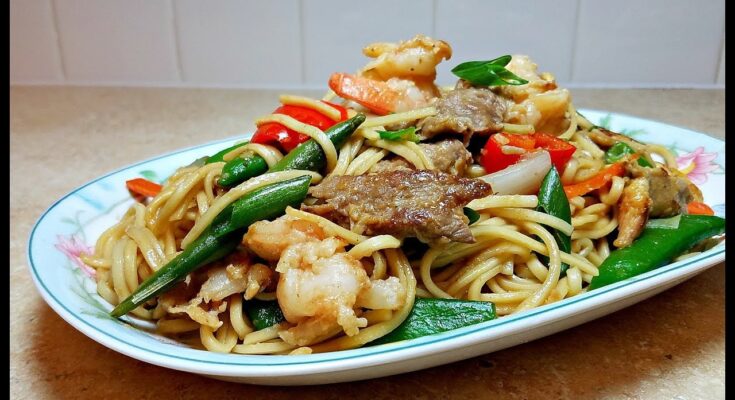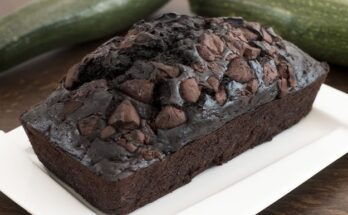Lo Mein Recipe: If you’re a fan of Asian cuisine, Lo Mein likely holds a special place in your heart. This versatile, flavorful noodle dish is a staple in many households and a go-to choice at Chinese restaurants. But did you know you can easily whip up restaurant-quality Lo Mein right in your kitchen?
This guide will walk you through every step of the process to create a dish that’s packed with deliciousness and entirely customizable to your taste.
Ingredients for Lo Mein
The foundation of Lo Mein is its signature noodles. Traditional Lo Mein noodles are egg-based, offering a chewy texture that pairs perfectly with the sauce. Soy sauce, oyster sauce, and sesame oil form the backbone of the dish’s savory flavor profile. These ingredients are must-haves to achieve the authentic taste of Lo Mein.
Customizable Vegetables and Proteins
One of the great things about Lo Mein is its flexibility. You can use whatever vegetables you have on hand, such as bell peppers, carrots, mushrooms, snow peas, or bok choy. Proteins like chicken, beef, shrimp, or tofu can elevate the dish and make it heartier.
Necessary Sauces and Spices
- Soy sauce (light and dark for depth of flavor)
- Oyster sauce for umami richness
- Sesame oil for nutty undertones
- Garlic and ginger to add aroma and depth
- Optional: chili paste or hot sauce for heat
Kitchen Tools You’ll Need
- A large wok or skillet for stir-frying
- A pot for boiling noodles
- A sharp knife and cutting board for preparing ingredients
Optional Tools for Convenience
- Tongs for mixing noodles
- A grater for finely mincing garlic and ginger
- A slotted spoon for draining cooked vegetables
How to Prepare Lo Mein
Prepping Ingredients
Start by washing and chopping your vegetables into thin, bite-sized pieces. Slice your chosen protein into thin strips for quick and even cooking. Mince fresh garlic and ginger to ensure they’re ready to infuse the oil with flavor.
Cooking the Noodles
Boil the Lo Mein noodles according to the package instructions. Make sure they’re al dente, as they’ll cook further when stir-fried. Drain the noodles and toss them lightly with sesame oil to prevent sticking.
Making the Sauce
In a small bowl, whisk together soy sauce, oyster sauce, a splash of water, and a drizzle of sesame oil. Adjust the proportions to your taste—add more soy sauce for saltiness or sesame oil for nuttiness.
Step-by-Step Lo Mein Cooking Process
Step 1: Preparing Vegetables and Proteins
Heat a wok or large skillet over medium-high heat. Add a tablespoon of oil and stir-fry your protein until fully cooked. Remove it from the pan and set it aside. In the same pan, add more oil and stir-fry the vegetables until they’re crisp-tender, about 3–5 minutes.
Step 2: Cooking the Noodles to Perfection
Ensure your noodles are well-drained before adding them to the dish. If necessary, rinse them under cold water to stop the cooking process and keep them from sticking.
Step 3: Stir-Frying the Vegetables and Proteins
Add your cooked protein back into the pan with the vegetables. Stir-fry them together for a minute to blend their flavors.
Step 4: Adding the Sauce
Pour the prepared sauce into the wok and mix well. Let it bubble slightly to thicken and coat the vegetables and protein evenly.
Step 5: Combining the Noodles and Final Stir-Fry
Finally, toss the cooked noodles into the wok. Use tongs or chopsticks to combine everything thoroughly. Stir-fry for an additional 2–3 minutes, ensuring the sauce coats every strand of noodle.
Tips for Perfect Lo Mein
Balancing Flavors
Taste as you go! Adjust the saltiness, sweetness, or spiciness by tweaking the sauce ingredients. A splash of rice vinegar or a pinch of sugar can add complexity.
Achieving the Ideal Texture
Cook the noodles until they’re firm and slightly chewy. Overcooked noodles can make the dish mushy and less enjoyable.
Common Mistakes to Avoid
Overcooking the Noodles
Always undercook the noodles slightly, as they’ll continue to cook when stir-fried with the sauce and vegetables.
Using the Wrong Sauce
Stick to soy sauce, oyster sauce, and sesame oil for an authentic flavor. Avoid overly sweet or tangy sauces like teriyaki unless you’re experimenting with a fusion twist.
Lo Mein Variations
Vegetarian Lo Mein
For a vegetarian twist, skip the meat and load up on vegetables like broccoli, bell peppers, mushrooms, and zucchini. Add a handful of tofu or edamame for protein. For an even richer flavor, sprinkle toasted sesame seeds or crushed peanuts on top before serving.
Spicy Lo Mein
Spicy food lovers, this one’s for you! Add a spoonful of chili paste, Sriracha, or crushed red pepper flakes to the sauce. For an extra kick, toss in thinly sliced jalapeños or sprinkle cayenne pepper during stir-frying.
Seafood Lo Mein
Shrimp, scallops, or even crab meat can elevate your Lo Mein to a whole new level. Be sure to sauté seafood separately until fully cooked, then mix it with the vegetables and noodles. A splash of lemon juice can also enhance the seafood’s natural flavors.
Gluten-Free Lo Mein
To make gluten-free Lo Mein, swap traditional egg noodles for gluten-free rice noodles or zoodles (spiralized zucchini noodles). Use tamari or coconut aminos instead of soy sauce and ensure the oyster sauce is gluten-free.
Serving and Storing Lo Mein
How to Serve Lo Mein
Serve Lo Mein piping hot, straight from the wok, for the best flavor and texture. Pair it with chopsticks or a fork and garnish with green onions or sesame seeds for a restaurant-style presentation. Adding a drizzle of chili oil on top can give the dish an irresistible sheen.
Storing Leftovers
Lo Mein stores well and makes a great meal prep option. Place leftovers in an airtight container and refrigerate for up to 3 days. Reheat in a skillet over medium heat with a splash of water to loosen the sauce and restore its freshness. Avoid reheating in the microwave to preserve the texture of the noodles.
Health Benefits of Lo Mein
Nutritional Value of Ingredients
Lo Mein can be a balanced meal, providing carbs, protein, and a variety of vitamins and minerals from the vegetables. Choose whole-grain noodles for added fiber and use lean proteins to keep it lighter.
Healthier Alternatives for Lo Mein
If you’re watching your calorie intake, you can reduce the amount of oil or use a non-stick pan. Opt for low-sodium soy sauce and increase the ratio of vegetables to noodles for a nutrient-dense meal.
Pairing Lo Mein with Other Dishes
Best Side Dishes to Serve with Lo Mein
- Spring Rolls: Crispy on the outside, these pair perfectly with Lo Mein.
- Hot and Sour Soup: A comforting starter to complement the noodles.
- Steamed Dumplings: Their savory filling makes them a great side option.
Drinks to Accompany Lo Mein
Pair your Lo Mein with jasmine tea or a light, fruity white wine. For non-alcoholic options, try sparkling water infused with lime or a chilled lemonade.
FAQs about Lo Mein Recipe
What’s the difference between Lo Mein and Chow Mein?
The primary difference lies in the cooking method and texture. Lo Mein is soft and saucy, as the noodles are tossed with the sauce, while Chow Mein involves stir-frying the noodles until crispy.
Can I use spaghetti instead of traditional noodles?
Yes! Spaghetti or linguine can work as substitutes if Lo Mein noodles aren’t available. Cook them al dente and toss with sesame oil for a similar texture.
How do I make the dish spicier?
To spice up your Lo Mein, add chili paste, Sriracha, or crushed red pepper flakes. You can also mix in spicy chili oil for a deeper heat.
Is Lo Mein gluten-free?
Traditional Lo Mein noodles contain wheat, but you can use gluten-free noodles and tamari instead of soy sauce to make the dish gluten-free.
Can I freeze cooked Lo Mein?
Yes, you can freeze Lo Mein in an airtight container for up to 2 months. To reheat, thaw it overnight in the fridge and stir-fry it with a splash of water or soy sauce to refresh the flavors.
Conclusion
Making Lo Mein at home is not only cost-effective but also a delightful way to customize your favorite dish to your taste. Whether you like it loaded with veggies, fiery with spice, or rich with seafood, the possibilities are endless. This step-by-step guide ensures you can create a delicious, restaurant-style Lo Mein that your family and friends will rave about. So, grab your wok, gather your ingredients, and let the cooking adventure begin!



